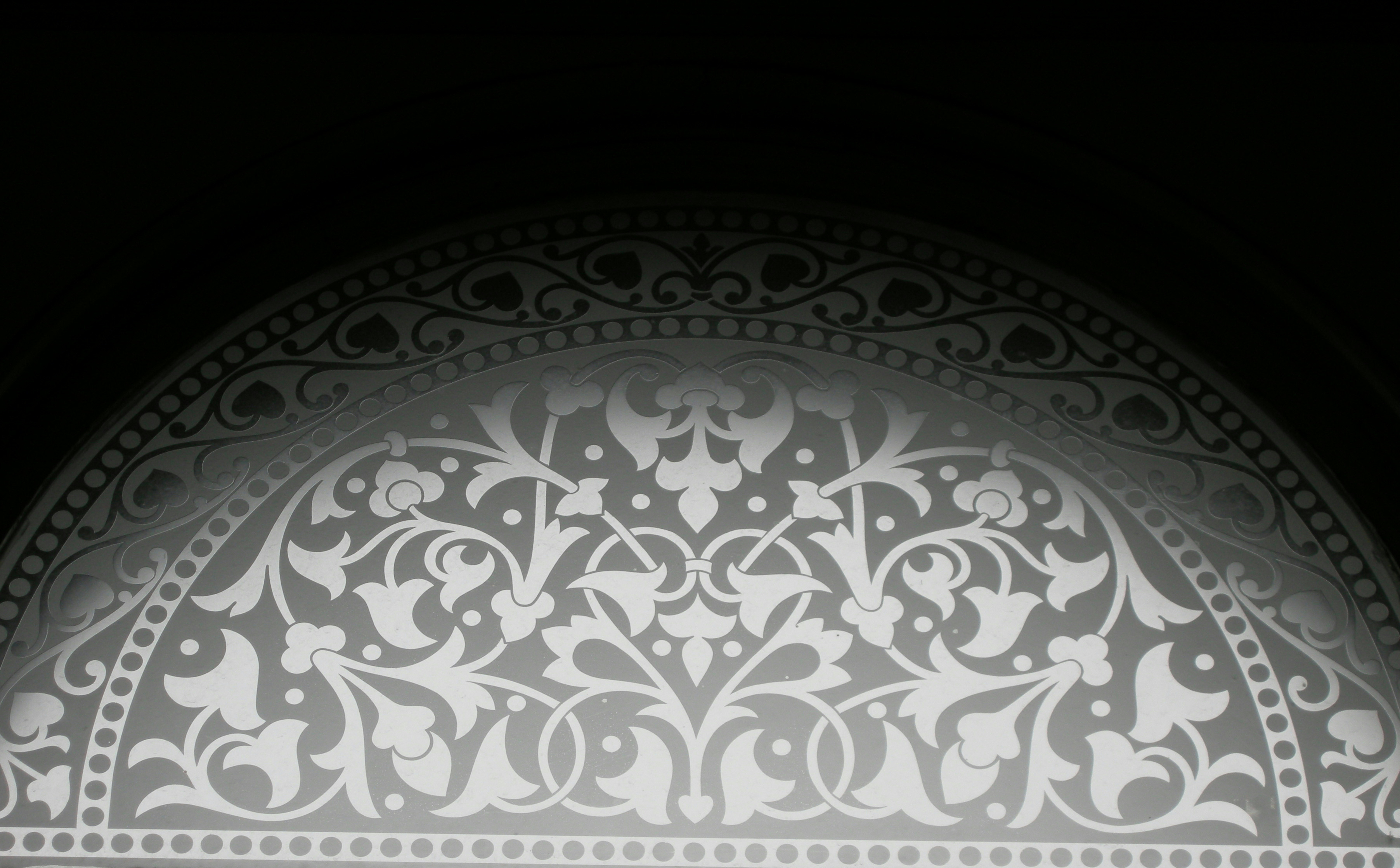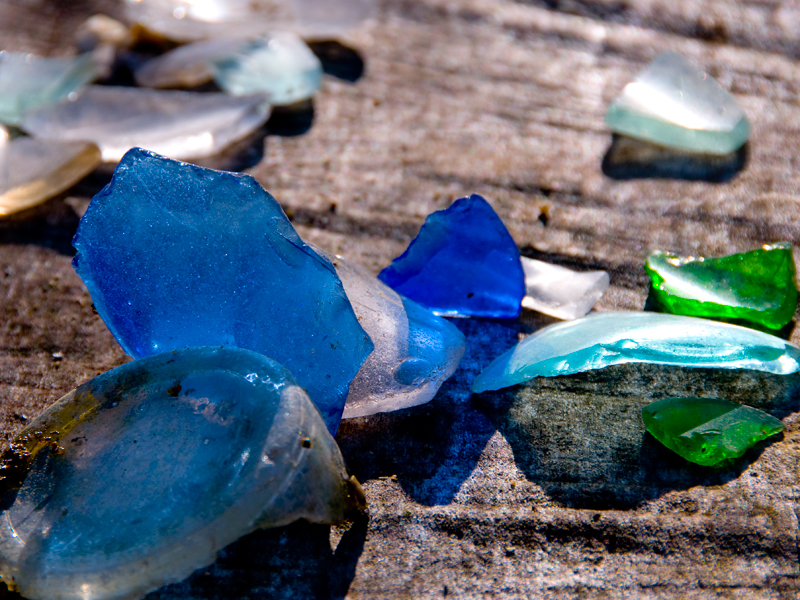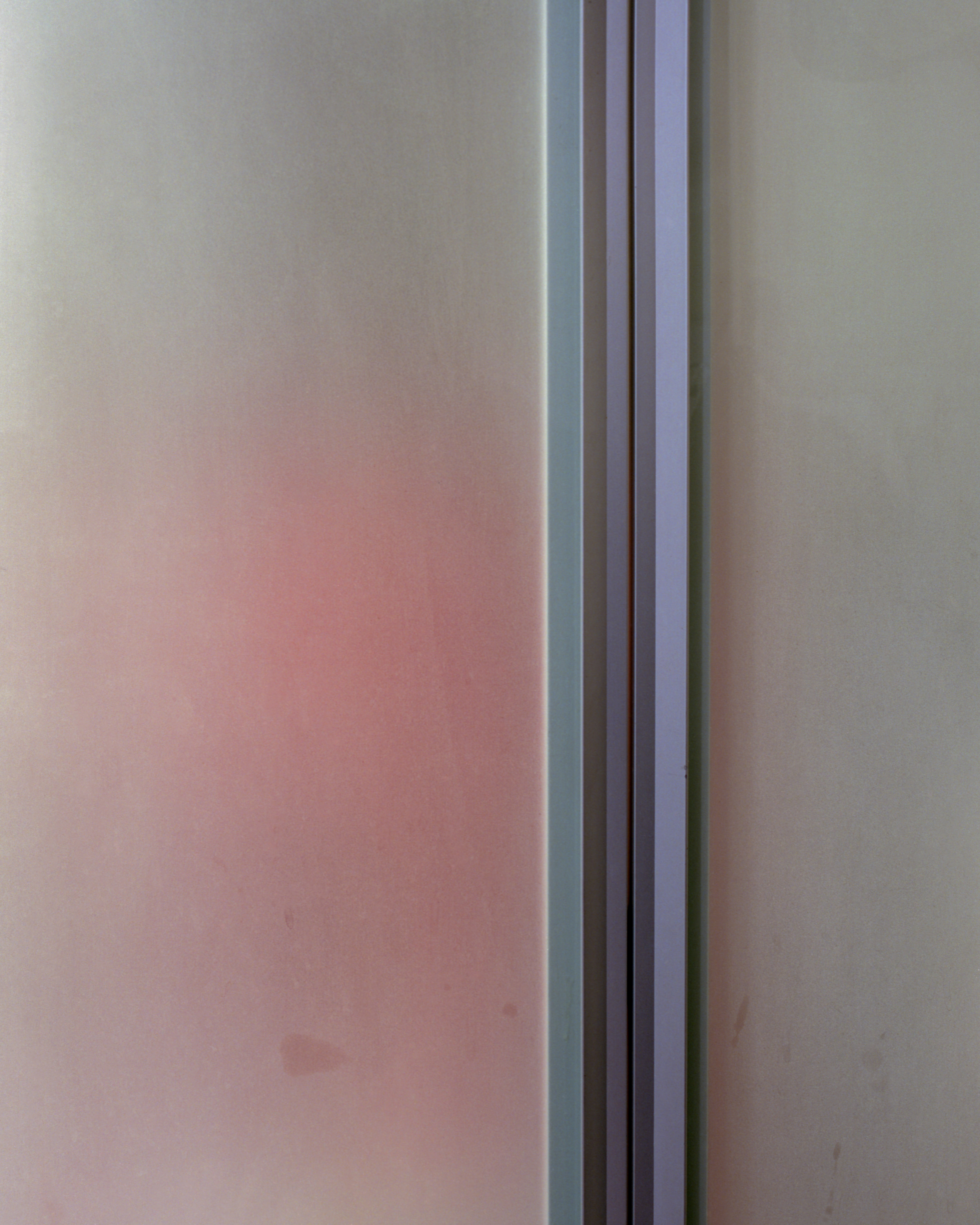|
Etching (glass)
Glass etching, or "French embossing", is a popular technique developed during the mid-1800s that is still widely used in both residential and commercial spaces today. Glass etching comprises the techniques of creating art on the surface of glass by applying acidic, caustic, or abrasive substances. Traditionally this is done after the glass is blown or cast, although mold-etching has replaced some forms of surface etching. The removal of minute amounts of glass causes the characteristic rough surface and translucent quality of frosted glass. Techniques Various techniques are used to achieve an etched surface in glass, whether for artistic effect, or simply to create a translucent surface. Acid etching is done using hexafluorosilicic acid (H2SiF6) which, when anhydrous, is colourless. The acid can be prepared by mixing quartz powder (silicon dioxide), calcium fluoride, and concentrated sulfuric acid; the acid forms after the resulting mixture is heated and the fumes (silicon tetra ... [...More Info...] [...Related Items...] OR: [Wikipedia] [Google] [Baidu] |
Conrad Schmitt Studios
Conrad Schmitt Studios is an architectural arts studio located in New Berlin, Wisconsin. It provides ecclesiastical art, stained glass artistry, art glass, decorative painting, mosaics, murals and sculptural arts. The studio specializes in restoration services for buildings of architectural, historical and religious significance. Founded in 1889 by German-American artist Conrad Schmitt, the company is one of the oldest and largest glass studios in the United States. History In 1889, Bavarian immigrant and formally trained artist, Conrad Schmitt, organized the Conrad Schmitt Studios with a focus on stained glass, decorative painting, and liturgical artwork. Originally located at 223 2nd Street in Milwaukee, Wisconsin, the studio was among the city's pioneer businesses. As one of the few art studios with the capacity to handle large-scale interior design projects, it quickly gained a national reputation and participated in increasingly complex projects across the country. Some ... [...More Info...] [...Related Items...] OR: [Wikipedia] [Google] [Baidu] |
Sea Glass
Sea glass and beach glass are naturally weathered pieces of glass, which often have the appearance of tumbled stones. "Sea glass" is physically and chemically weathered glass found on beaches along bodies of salt water. These weathering processes produce natural frosted glass. "Genuine sea glass" can be collected as a hobby and is used for decoration, most commonly in jewelry. "Beach glass" comes from fresh water and is often less frosted in appearance than sea glass. Sea glass takes 20 to 40 years, and sometimes as much as 100 to 200 years, to acquire its characteristic texture and shape. It is also colloquially referred to as "drift glass" from the longshore drift process that forms the smooth edges. In practice, the two terms are used interchangeably. Formation Sea glass begins as normal shards of broken glass that are then persistently tumbled and ground until the sharp edges are smoothed and rounded. In this process, the glass loses its slick surface but gains a frost ... [...More Info...] [...Related Items...] OR: [Wikipedia] [Google] [Baidu] |
Satin Glass
Satin glass is glass that has been chemically treated to give it a misty-looking finish. The term "satin glass" is frequently used to refer to a collectible type of pressed glass. Satin glass can be used for decorative items. However, satin glass is also used to provide privacy where the full transparency of glass is undesirable. The satin finish is produced by treating the glass with hydrofluoric acid or hydrofluoric acid fumes. Satin glass was first made as decorative pressed glass in England and the United States during the 1880s. Many companies have produced this type of satin glass. It is similar to milk glass in that it is opaque, and has decorative surface patterns molded into it, however, satin glass has a satin, rather than glossy surface. Satin glass is typically tinted with a pastel color, blue is the most common. It was produced by the Fenton Art Glass Company between 1972 and 1984 in large quantities. Satin glass, like milk glass and carnival glass, is ... [...More Info...] [...Related Items...] OR: [Wikipedia] [Google] [Baidu] |
Laser Engraving
Laser engraving is the practice of using lasers to engrave an object. Laser marking, on the other hand, is a broader category of methods to leave marks on an object, which in some cases, also includes color change due to chemical/molecular alteration, charring, foaming, melting, ablation, and more. The technique does not involve the use of inks, nor does it involve tool bits which contact the engraving surface and wear out, giving it an advantage over alternative engraving or marking technologies where inks or bit heads have to be replaced regularly. The impact of laser marking has been more pronounced for specially designed "laserable" materials and also for some paints. These include laser-sensitive polymers and novel metal alloys. The term laser marking is also used as a generic term covering a broad spectrum of surfacing techniques including printing, hot-branding and laser bonding. The machines for laser engraving and laser marking are the same, so that the two terms are ... [...More Info...] [...Related Items...] OR: [Wikipedia] [Google] [Baidu] |
Glass Engraving
Engraved glass is a type of decorated glass that involves shallowly engraving the surface of a glass object, either by holding it against a rotating wheel, or manipulating a "diamond point" in the style of an engraving burin. It is a subgroup of glass art, which refers to all artistic glass, much of it made by "hot" techniques such as moulding and blowing melting glass, and with other "cold" techniques such as glass etching which uses acidic, caustic, or abrasive substances to achieve artistic effects, and cut glass, which is cut with an abrasive wheel, but more deeply than in engraved glass, where the engraving normally only cuts deeply enough into the surface to leave a mark. Usually the engraved surface is left "frosted" so a difference is visible, while in cut glass the cut surface is polished to restore transparency. Some pieces may combine two or more techniques. There are several different techniques of glass engraving. It has been practised since ancient times, includin ... [...More Info...] [...Related Items...] OR: [Wikipedia] [Google] [Baidu] |
Zwickau
Zwickau (; is, with around 87,500 inhabitants (2020), the fourth-largest city of Saxony after Leipzig, Dresden and Chemnitz and it is the seat of the Zwickau District. The West Saxon city is situated in the valley of the Zwickau Mulde (German: ''Zwickauer Mulde''; progression: ), and lies in a string of cities sitting in the densely populated foreland of the Elster and Ore Mountains stretching from Plauen in the southwest via Zwickau, Chemnitz and Freiberg to Dresden in the northeast. From 1834 until 1952, Zwickau was the seat of the government of the south-western region of Saxony. The name of the city is of Sorbian origin and may refer to Svarog, the Slavic god of fire and of the sun. Zwickau is the seat of the West Saxon University of Zwickau (German: ''Westsächsische Hochschule Zwickau'') with campuses in Zwickau, Markneukirchen, Reichenbach im Vogtland and Schneeberg (Erzgebirge). The city is the birthplace of composer Robert Schumann. As cradle of Audi's forerunner ... [...More Info...] [...Related Items...] OR: [Wikipedia] [Google] [Baidu] |
Depression Glass
Depression glass is glassware made in the period 1929–1939, often clear or colored translucent machine-made glassware that was distributed free, or at low cost, in the United States and Canada around the time of the Great Depression. Depression glass is so called because collectors generally associate mass-produced glassware in pink, yellow, crystal, green, and blue with the Great Depression in America. History The Quaker Oats Company, and other food manufacturers and distributors, put a piece of glassware in boxes of food, as an incentive to purchase. Some movie theaters and businesses handed out pieces to patrons. Most of this glassware was made in the Ohio River Valley of the United States, where access to raw materials and power made manufacturing inexpensive in the first half of the twentieth century. More than twenty manufacturers made more than 100 patterns, and entire dinner sets were made in some patterns. Common colors are clear (crystal), pink, pale blue, green, a ... [...More Info...] [...Related Items...] OR: [Wikipedia] [Google] [Baidu] |
Molding (process)
Molding (American English) or moulding (British and Commonwealth English; see spelling differences) is the process of manufacturing by shaping liquid or pliable raw material using a rigid frame called a mold or matrix. This itself may have been made using a pattern or model of the final object. A mold or mould is a hollowed-out block that is filled with a liquid or pliable material such as plastic, glass, metal, or ceramic raw material. The liquid hardens or sets inside the mold, adopting its shape. A mold is a counterpart to a cast. The very common bi-valve molding process uses two molds, one for each half of the object. Articulated molds have multiple pieces that come together to form the complete mold, and then disassemble to release the finished casting; they are expensive, but necessary when the casting shape has complex overhangs. Piece-molding uses a number of different molds, each creating a section of a complicated object. This is generally only used for larger a ... [...More Info...] [...Related Items...] OR: [Wikipedia] [Google] [Baidu] |
Abrasive Blasting
Sandblasting, sometimes known as abrasive blasting, is the operation of forcibly propelling a stream of abrasive material against a surface under high pressure to smooth a rough surface, roughen a smooth surface, shape a surface or remove surface contaminants. A pressurised fluid, typically compressed air, or a centrifugal wheel is used to propel the blasting material (often called the ''media''). The first abrasive blasting process was patented by Benjamin Chew Tilghman on 18 October 1870. There are several variants of the process, using various media; some are highly abrasive, whereas others are milder. The most abrasive are shot blasting (with metal shot) and sandblasting (with sand). Moderately abrasive variants include glass bead blasting (with glass beads) and plastic media blasting (PMB) with ground-up plastic stock or walnut shells and corncobs. Some of these substances can cause anaphylactic shock to individuals allergic to the media. A mild version is sodablastin ... [...More Info...] [...Related Items...] OR: [Wikipedia] [Google] [Baidu] |
Frosted Glass
Frosted glass is produced by the sandblasting or acid etching of clear sheet glass. This creates a pitted surface on one side of the glass pane and has the effect of rendering the glass translucent by scattering the light which passes through, thus blurring images while still transmitting light. It has 10-20% Opacity. Applications: * To achieve visual privacy while still allowing light to pass through. * Decorative patterns may be created on plain glass by using wax or other inhibitors to retain transparent areas. * To distribute light uniformly in a photographic contact printer. * To create an airtight seal in tubes. The frosted glass effect can also be achieved by the application of vinyl film, used as a sort of stencil on the glass surface. "Photo-resist", or photo-resistant film is also available, which can be produced to mask off the area surrounding a decorative design, or logo on the glass surface. A similar effect may also be accomplished with the use of canned fro ... [...More Info...] [...Related Items...] OR: [Wikipedia] [Google] [Baidu] |



.jpg)



